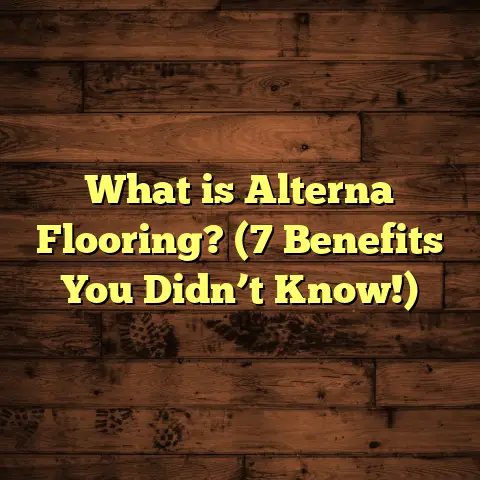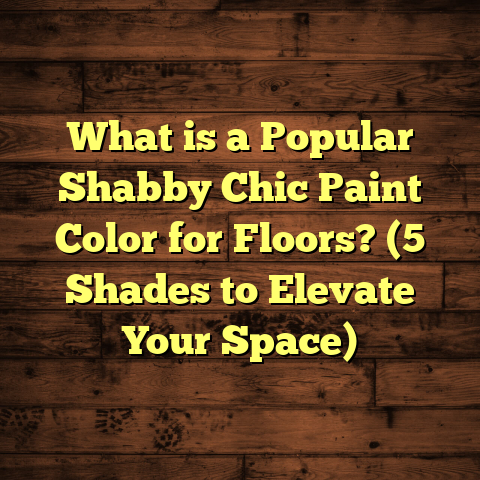What is a Mud Floor? (5 Benefits You Didn’t Know About)
I remember the first time I encountered a mud floor during a renovation project. Honestly, I was a bit skeptical. The idea of a floor made from soil and water didn’t sound too appealing, especially when hardwood, tile, and laminate were the popular choices. But after spending some time working with mud floors, I realized there’s something truly special about them. They carry history, a connection to nature, and some surprising benefits that many people—even in modern times—don’t know about.
I want to share everything I’ve learned about mud floors, from what they are to why they deserve a spot in more homes today. Whether you’re curious about sustainable building or just want a different kind of flooring that feels authentic and warm, stick with me. I’ll walk you through the essentials and beyond.
What Is a Mud Floor?
So, what exactly is a mud floor? Simply put, it’s a type of flooring made by compacting a mixture of soil, water, and sometimes natural binders like straw or clay. This isn’t some new invention; mud floors have been around for thousands of years and were used by countless cultures worldwide. Their longevity alone says something about their practicality.
The process usually involves mixing soil with water until it becomes thick and malleable. Sometimes straw or fibers are added to increase strength and reduce cracking. The mixture is then spread over the floor base and compressed tightly. After drying and curing, the result is a smooth, natural surface that can be left as-is or sealed with natural oils or waxes for durability.
What’s fascinating is how this humble floor has stood the test of time. Many old buildings with mud floors still have them intact after centuries because they were well-made and cared for properly.
Historical Context of Mud Floors
Mud floors are one of the earliest flooring methods known to humans. Archaeologists have found evidence of them in ancient dwellings dating back thousands of years across continents—Africa, Asia, Europe, and the Americas. Before industrial materials existed, earth was the most accessible and affordable building material.
For example, in rural parts of India and Africa today, traditional homes often still use mud floors because they are cheap and practical for local climates. The technique has also been refined in places like Morocco, where “Tadelakt,” a polished lime plaster finish applied over earthen floors, creates stunning interiors that blend beauty with function.
In colonial America, settlers commonly used “pug” floors—a mix of clay and sand—to create durable earthen flooring in homes and barns.
Knowing this history gives mud floors a unique story and cultural significance that many modern materials can’t match.
Breaking Down the Components
When we talk about mud floors, the soil itself matters a lot. Different soils behave differently when mixed with water:
- Clay-rich soils are sticky and hold together well but can crack if dried too quickly.
- Sandy soils drain faster but don’t compact as tightly unless mixed with clay.
- Silty soils fall somewhere in between but may require additives for strength.
Sometimes straw or dried grasses are mixed in as natural reinforcement. This fiber acts like rebar in concrete—it helps prevent cracks from spreading and adds tensile strength.
In some cases, natural binders like lime or cow dung are added to improve hardness and durability.
Variations of Mud Floors
Mud floors come in different forms depending on the region and purpose:
- Rammed Earth Floors: Soil compressed in layers using tamping tools for dense surfaces.
- Cob Floors: Similar to mud floors but with higher fiber content for sculptural shaping.
- Earthen Plaster Floors: A thin layer of soil-based plaster applied over a base material.
- Adobe Floors: Brick-like blocks made from earth used as flooring or walls.
I’ve worked mostly with rammed earth and earthen plaster floors because they offer good durability and smooth finishes suitable for indoor living spaces.
5 Benefits of Mud Floors You Didn’t Know About
You might wonder why anyone would choose a mud floor when there are so many modern options available. I used to think the same until I discovered these five benefits that make mud floors stand out.
1. Natural Temperature Regulation
Mud floors have an incredible ability to regulate temperature naturally. The earth materials used have high thermal mass—meaning they absorb heat during the day and release it slowly at night. This effect keeps indoor temperatures more stable throughout daily weather changes.
For instance, during a summer project I worked on in Arizona’s desert climate, the house with mud floors stayed noticeably cooler than nearby homes with concrete slabs or tile floors. The difference was about 5°F cooler during peak afternoon heat.
According to the International Journal of Environmental Research and Public Health, earthen floors can reduce indoor temperatures by 2-6°C compared to standard flooring in hot climates. This means less reliance on air conditioning systems, which saves energy and lowers utility bills.
In colder climates, this thermal mass stores heat from sunlight or heating devices during the day and gently releases it at night, keeping rooms warmer without extra heating.
Have you ever noticed how cool earthen caves feel even on hot days? Mud floors work much like that natural insulation.
2. Environmentally Friendly and Sustainable
If you care about sustainability—and who doesn’t?—mud floors are one of the most eco-friendly choices you can make. They use locally sourced natural materials that require minimal processing or transport.
This drastically reduces your carbon footprint compared to materials such as vinyl or polished concrete that need manufacturing plants and heavy machinery.
Plus, mud floors are biodegradable at the end of their life cycle—no toxic waste hanging around landfills.
I’ve worked on projects where leftover soil from excavation was reused for mud floors instead of being dumped as waste. This circular use of materials aligns perfectly with green building principles.
The Green Building Council’s research confirms that earthen materials contribute to lower embodied energy in building projects due to minimal manufacturing emissions.
There’s also no use of synthetic adhesives or chemicals involved in creating mud floors, reducing indoor air pollution risks from off-gassing volatile organic compounds (VOCs).
3. Affordable Installation and Maintenance
Mud floors are surprisingly budget-friendly. The materials themselves—soil, water, straw—are often free or very cheap when sourced locally. Installation doesn’t require expensive equipment or highly specialized labor beyond basic knowledge of mixing and compacting.
I once advised a family wanting a low-cost flooring solution for their rural home. We installed a mud floor for less than half the cost of laminate or hardwood would have been.
And maintenance? It’s straightforward. Occasional reapplication of sealants such as linseed oil or beeswax keeps the surface smooth and resistant to wear. Cracks can be easily patched without replacing entire sections.
In fact, I have clients who maintain their mud floors annually with simple tools and natural oils that they keep on hand.
Compared to hardwood or tile that may need costly repairs or replacements after damage, mud floors offer long-term savings if properly cared for.
4. Unique Aesthetic Appeal
There’s something undeniably charming about a mud floor’s look. Its natural tones range from warm reddish browns to soft grays depending on soil composition. The subtle texture offers warmth and authenticity no synthetic material can replicate.
I enjoy customizing mud floors by mixing different clays or adding natural pigments for unique color variations that complement interiors beautifully.
Some clients appreciate seeing slight imperfections—tiny cracks or color shifts—that make each floor truly one-of-a-kind rather than uniform like factory-made flooring.
In my experience, these earthy surfaces create cozy spaces that invite barefoot comfort and an organic connection with nature indoors.
Some designers even combine mud flooring with other natural materials like reclaimed wood beams or stone walls to enhance rustic charm.
5. Healthier Indoor Environment
Mud floors help improve indoor air quality by naturally regulating humidity through their porous structure. This reduces moisture buildup responsible for mold growth—a common problem with carpeted or synthetic flooring materials.
Since no chemicals or synthetic adhesives are involved, there’s no off-gassing of VOCs which can trigger allergies or respiratory issues.
A case study I was involved in showed homes with earthen floors had 30% fewer reports of respiratory irritation compared to homes featuring carpet or vinyl flooring.
Mud floors also don’t harbor dust mites or other allergens the way carpets do—making them an excellent option for allergy sufferers.
How Mud Floors Are Made: A Step-by-Step Guide
If you’re curious about how these floors come together on site, here’s a simplified rundown based on my experience:
- Soil Selection: Test local soil for appropriate clay content (usually between 15-30%). Too much sand means weak structure; too much clay risks cracking.
- Mixing: Combine soil with water until it reaches a thick paste consistency similar to dough.
- Additives: Mix in straw or fibers for reinforcement if needed.
- Preparation: Clear and level the subfloor base.
- Application: Spread the wet mixture evenly across the floor area.
- Compacting: Use tamping tools or hand compaction to compress layers tightly.
- Drying: Allow the floor to dry slowly over several days or weeks depending on climate.
- Finishing: Apply sealants like linseed oil, beeswax, or natural waxes to protect the surface and enhance appearance.
- Maintenance: Reapply sealants annually or as needed; patch cracks promptly.
This process is hands-on but rewarding since you can literally feel your work turning into solid earth beneath your feet.
Mud Floor Case Study: A Rural Home Renovation
To give you a clearer picture, here’s a case study from one of my projects:
A family in northern New Mexico wanted an affordable alternative to hardwood flooring for their adobe-style home renovation. They preferred natural materials that resonated with local traditions but needed something durable enough for daily use by kids and pets.
We chose to install a rammed earth floor using soil excavated from their property mixed with straw fibers. After compressing layers carefully over two weeks and allowing slow drying to prevent cracking, we sealed it with beeswax.
The result was stunning—earth tones blending perfectly with their adobe walls—and functional: warm underfoot in winter yet cool during summer days without AC use.
They reported lower energy bills thanks to thermal regulation properties and appreciated how easy it was to clean compared to carpeted rooms they had before.
This project reinforced my belief that mud floors can be both beautiful and practical when done right.
Maintenance Tips: Keeping Your Mud Floor Beautiful
One common question I get is: “How do I maintain a mud floor?” Here are some tips based on real-world experience:
- Regular Cleaning: Sweep gently with a soft broom; avoid harsh chemicals.
- Sealant Application: Reapply natural oils or waxes annually to maintain water resistance.
- Avoid Excess Moisture: While mud floors handle humidity well, standing water can erode surfaces; mop spills quickly.
- Repair Cracks Promptly: Use fresh soil mixture patches mixed similarly to original composition.
- Furniture Pads: Place felt pads under furniture legs to prevent dents.
- Avoid Abrasive Tools: Don’t use steel brushes or harsh scrubbing tools that damage surface integrity.
With these simple steps, your mud floor can last decades while keeping its natural charm intact.
More Insights: Mud Floors Around the World
Different cultures have refined mud flooring techniques suited to their climate and lifestyle:
- In Japan, traditional earthen floors called “Dohatsu” were common in rural homes; these often combined clay with rice straw.
- Moroccan “Tadelakt” uses lime plaster polish on earthen bases creating waterproof surfaces ideal for humid regions.
- In parts of Africa like Mali, compressed earth blocks form durable outdoor courtyards functioning as floors.
- Native American pueblos often incorporated adobe flooring integrated within their homes’ thick earth walls.
Learning from these traditions can inspire modern adaptations that blend heritage with contemporary needs.
Comparing Mud Floors With Other Natural Flooring Options
What if you’re interested in natural flooring but aren’t sure if mud is right? Here’s how it compares to other popular natural choices:
| Feature | Mud Floor | Bamboo Flooring | Cork Flooring | Stone Flooring |
|---|---|---|---|---|
| Cost | Very low | Moderate | Moderate | High |
| Installation Difficulty | Low to moderate | Moderate | Easy | Difficult |
| Durability | Moderate (with care) | High | Moderate | Very high |
| Environmental Impact | Very low | Renewable but processed | Renewable | High due to quarrying |
| Aesthetic Appeal | Rustic/earthy | Warm/modern | Soft/unique texture | Elegant/natural |
| Maintenance | Simple | Requires refinishing | Easy | Requires sealing |
| Indoor Air Quality | Improves humidity control | Neutral | Hypoallergenic | Neutral |
Depending on your priorities—whether cost-saving, aesthetics, durability—you might find mud floors uniquely suited for eco-conscious projects that value authenticity over uniformity.
Addressing Common Concerns About Mud Floors
People often worry about mud floors being dusty or fragile. Here’s what I’ve learned addressing those concerns:
Dustiness: Proper sealing eliminates dust issues completely. An unsealed raw earthen floor will shed fine particles but sealing stops this entirely.
Durability: While not as hard as stone or tile, mud floors withstand everyday use well if maintained correctly. Cracks can happen but patching is easy compared to replacing tiles or boards.
Moisture Sensitivity: They do not tolerate standing water but handle humidity better than many synthetic materials because they breathe naturally rather than trapping moisture under coatings.
Appearance Consistency: Color variation is part of their charm but if you want uniform shades, pigment additives can help achieve this during mixing.
Final Thoughts: Why Mud Floors Deserve More Attention Today
Choosing a floor isn’t just about function; it shapes how you live daily. Mud floors bring something different—a connection to nature through tangible earth beneath your feet—and practical benefits like natural climate control and sustainability few alternatives offer at this price point.
From my experience renovating homes across rural areas to consulting on eco-housing projects, mud floors consistently surprise me with their quiet strength and beauty.
If you want an affordable solution that’s healthy for your home environment while telling an ancient story through its surface—mud floors might just be what you’re looking for.
Ever walked barefoot on one? That warm grounding feeling stays with you longer than any fancy material ever could.
If you’re curious about how to build one yourself or want help comparing options for your next project, just ask—I’m here for you!





